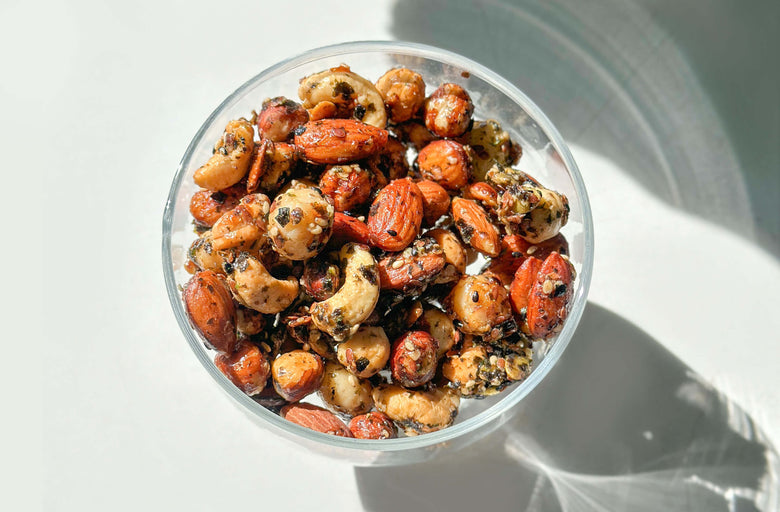There’s no one silver bullet when it comes to creating a thriving body—diversity is key—but in a desert-island situation, eating leafy greens is the most profound way to transform your health. And we aren’t talking about a wilting and frightfully small side salad; the real magic happens at about 4 to 6 cups every single day.
Why Greens Are Crucial
With every crunch of organic roughage, you’re changing your microbiome, and getting closer to a thriving, powerful, efficient body. This internal ecosystem is the control center for our metabolism, nutrient absorption, mood, cognition, energy levels, libido, and hormones. The good news is diet plays a huge role in how the microbiome functions—and it likes fiber best. Plant fiber boasts a one-two punch for the body: the insoluble fiber works as a scrub brush, cleaning along the GI tract and ridding the body of excess estrogen, inflammatory properties, and metabolic waste from the system; the soluble fiber, meanwhile, feeds the symbiotic bacteria to balance hormones, promote microbial diversity, and keep cravings in check.
By changing the landscape of bacteria, leafy greens have the power to “crowd out” the barrage of things impacting our gut: stress, for example, has been shown to change the microbiome but promising studies reflect that a high-fiber diet can combat those negative effects. Even an occasional cocktail or flight of french fries is more easily balanced by way of a high-fiber diet, according to health experts like integrative gastroenterologist, Dr. Robynne Chutkan. “It’s the absence of nourishing food rather than the presence of the not-so-good stuff that usually leads to a depleted microbiome,” Chutkan says.
It’s the absence of nourishing food rather than the presence of the not-so-good stuff that usually leads to a depleted microbiome.
An Ally In The Digestive Journey
Beyond fiber, greens promote vitality at every stop as your body absorbs food. Digestive enzymes, prevalent in a plant’s web of nutrients, stimulate bile and acidity in the mouth and stomach. This is a crucial step to fully absorb nutrients—a lack of which causes a buildup of fermented, undigested food and excess bloat. In addition, the fact that greens are living foods and water-rich means they act as a sort of irrigation system for the colon. Think of the sharp turns of the colon and large intestine like a slide, requiring hydration to create ease for waste to exit and ensure there are no stagnant toxins and excess mucus sticking to the walls. Sakara founder and co-CEO, Whitney Tingle notes that hydrating her colon served as a cornerstone to overcoming her decade-long battle with cystic acne. “I thought I was eating ‘healthy foods’ like gluten-free crackers and avocado toast. But those foods are lacking water and hydration,” Tingle says. “They contained fiber, but they were not helping my “regularity” problems, which was a huge part of my gut imbalance and the inflammation that showed up on my face. I thought I had a skin problem, but it was actually a gut problem. Flooding my diet with water-rich foods (and fiber-rich foods that contained water too) helped my body to heal and rebalance and my skin gradually cleared.”
Eating Sunshine
It would be remiss to gloss over a green’s most obvious superpower: chlorophyll. The verdant pigment is one of the most potent sources of detoxification on the planet, and plants use it to trap light needed for photosynthesis, generating oxygen. By consuming chlorophyll, you are actively absorbing sun energy and oxygen, the two components to life. The full scope of its healing powers have yet to be explored, but its properties support the renewal of damaged tissue, building blood, increasing intestinal flora, and improving phase II of liver function.
Above all, leafy greens are high-vibrational foods that help create a fully-functioning body. Juicy, living, water-rich, oxygenated plants reflect back into the body and steer us away from the markers of disease: inflammation, dehydration, lethargy, and stress.
Plant fiber boasts a one-two punch for the body
Putting Plants to Practice
While listing a green’s nutritional resume could make you a plant-rich convert in theory, the idea of “getting in your greens” can feel daunting in practice. Worse, you might think the only way to consume the life-changing volume is to resort to a monotonous cycle of salads. Sakara’s passion is to make nutrient-dense meals a creative and joyous experience, and we have found the best way to do that, by taking risks and expanding your greens repertoire wherever possible. For us, that means working with incredible purveyors, like Radicle Farms, who curate custom blends for us with over 30 different varieties of greens to spice it up (keeping us on our toes with nutrient-packed plants like da hong choi, nasturtium, marigold, and purple wood sorrel).
Below, we share seven greens you can spot in your farmer’s market for their texture, nutrient density, and complex flavor—trust us, there will be no need to cover up or drench in dressing.
7 Under-The-Radar Greens and What to Do With Them
Swiss Chard
The large fan-like leaf and hardy stem makes chard and its many varieties nature’s wraps; take advantage of their toughness and ample source of vitamin K by tucking in sliced cucumbers, carrots, olives, radishes, and adding a generous spoonful of hummus and tzatziki. Up the flavor ante with herbs and seasoning like dill, fennel, parsley, and celery salt.
Microgreens
Following the adage, small but mighty, microgreens are a more concentrated (and therefore more nutrient-dense) version of their mature counterpart—by some estimations, their nutritional content can be up to 40 times potent the parent plant. Cilantro microgreens doused atop a bowl of lentil pasta or pea shoots layered on a veggie sandwich are two delicious opportunities. Sprinkle them on everything from tacos to a Protein + Greens Super Powder smoothie.
Dandelion Greens
Dandelion is best known for its detoxifying properties, and its distinct bitterness. It also provides iron, magnesium, copper, and folate, as well as vitamins A, E, K, and B1 through 3. To benefit from its phytonutrient wonder, make a dandelion root herbal infusion. (To ensure you squeeze in enough fiber, use raw greens as the base of a salad, toss with high-quality olive oil and add lemon for acidic brightness. From there, a handful of walnuts, sliced blood oranges, and roasted beets does the trick.)
Radish Greens (or Beet Greens, Turnip Greens and other “tops”)
The tops of roots are some of the most nutrient-dense parts of the plant, with complex flavors and rich mouthfeel. Saute with olive oil and plenty of garlic as a side or finely chop and sprinkle on some roasted carrots or Brussels. They also work really well as soup bases: start with a mineral broth, add seaweed or kombu, blended in with the greens and water. Or, chop them up and use in place of scallions in miso soup. Or, for a squash-based soup, add garlic, ginger and then fold in blended greens for the best of both worlds.
Chicory
Chicory is bitter to be sure, but that is its superpower, stimulating bile and curbing sugar cravings. Radicchio, a variety of chicory, tastes delicious ripped up atop a slice of pizza—the bitterness adds a cool twist to a red sauce pie—or, create a simple salad with water-dense baby gems and butter lettuce, grainy mustard, olive oil, nuts, and seeds for a healthful first course.
Watercress
The peppery green boasts anticancer properties called glucosinolates and naturally decreases inflammation through dietary nitrates. It has a strong, almost fiery flavor profile but is delicious whipped into a pesto, paired with potato for a hearty soup, or sauteed alongside shiitake mushrooms.
Purslane
A hot plant in the beauty world, purslane offers up omega-3 fatty acids, melatonin, and a regenerative compound that research suggests can extend telomerase—prolonging the lifespan of cells and therefore serve as a natural anti-ager. Translation: stock up on this botanical. Noted for its succulent quality, it tastes best when paired with ripe tomatoes, lemon, cucumbers, shallot, and spinach. Another delicious summer salad idea: watermelon, mint, nut cheese, and purslane.
Ashitaba
Japanese for “tomorrow’s leaf,” Ashitaba is a flowering plant in the carrot family. It’s high in B vitamins—critical for cognitive health and energy—and a source of chalcones, a class of flavonoids and anti-inflammatory compounds. We suggest sprinkling as a garnish on a delicious salad, tucked into a sandwich, or atop avocado toast.
Words to the Wise:
Phase in your Fiber:
Transforming your diet from processed foods, dehydrating snacks, and on-the-go bites into one that’s flooded with plants and fiber can be disruptive. Bloating, gas, and a little bit of discomfort may be common for the first couple of days, even weeks. Don’t let that deter you. Ease in on the raw vegetables, and thoroughly chew to break down the food and avoid air bubbles.
Befriend a Farmer:
Turn a casual stroll through the farmer’s market into a ritual. Explore which herbs and plants look the freshest, and chat with the purveyors. They are an incredible, often untapped resource who can share how to use each plant and make the most intimidating vegetable into an ingredient you integrate weekly.
Get Inspired
Plants never cease to inspire. There are just so many ways to prepare them! Once you crack open that world, a diet filled with plants feels anything but restrictive. A well-stocked library pairs well with an abundant fridge, and here are some of our favorites:
- Eat Clean, Play Dirty
- High Vibrational Beauty
- Whole Food Cooking Everyday
- The Garden Chef
- Vegetable Kingdom
- Mostly Plants
- Raw: Recipes for a Modern Vegetarian Lifestyle
Explore More:






